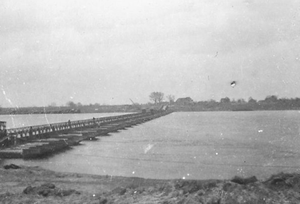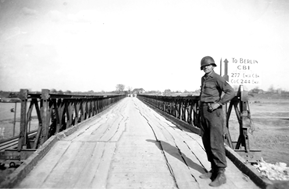Brightwood Boys, The History of the Men from
the North End of
Springfield, Massachusetts,
During World War II
by Christopher P. Montagna
CHAPTER 30
BREACHING THE RHINE
In Europe, the US Army was preparing breach the final barrier on its way to Berlin. For the first two months of 1945, Joe Montagna and members of the 277th saw service in Belgium, moving to Grooten-Spauwen, Belgium where Company “C” took over from the 554th Heavy Pontoon Battalion the operation of cutting and hauling logs for 13 saw mills for lumber needed for the pending Rhine River crossing.
On the morning of March 24, Joe Montagna and the 277th Engineers were bivouacked at Monsterhof, Germany. The sky over Monsterhof was thick with hundreds of airplanes towing gliders behind them and hundreds of troop aircraft containing paratroopers and supplies as part of “Operation Varsity”. Operation Varsity would be the last full scale airborne drop of World War II and the assignment went to the 17th Airborne Division.
Riding along in one of the gliders was Pvt. Alexander Samol who was participating in the last full scale airborne operation of the war and the first glider landing for the 194th GIR. The 194th's mission was to land north of Wesel in Landing Zone , a large flat area where the Issel River and the Issel Canal merge and then to seize the crossing over the Issel and protect the division's right flank.
The 194th had the misfortune of flying over a concentration of German antiaircraft weapons. Two-thirds of the C-47's were either damaged or in flames. The pilots remained with the aircrafts until they released the gliders which landed amid German Artillery units. The German gun crews immediately repositioned their guns for direct fire. It was a fluid situations for a period but the glider troops prevailed and were able to overrun the German positions. By mid-afternoon on 24 March 1945 the 194th had secured its objective including the destruction of 42 artillery pieces, ten tanks and the capture of 1,000 German prisoners. But as the men regrouped, Alexander Samol was listed as missing in action.
As part of the Allied plan to breach the Rhine River, the 277th CEB (assigned to the 1143rd Engineer Combat Group which included the 336th and 244th CEB) moved to Wallach, Germany on March 25, 1945 and started construction the following day of a Floating Bailey Bridge across the Rhine River in the vicinity of Wallach.
 During construction the noise from German anti-aircraft fire reminded the men that the German’s still enjoyed the fight. The men were subjected to nighttime strafing, but the men continued on with the construction. They understood the importance of bridging the Rhine if the war was to be won. Throughout the construction the men watched as airplanes went down in flames.
During construction the noise from German anti-aircraft fire reminded the men that the German’s still enjoyed the fight. The men were subjected to nighttime strafing, but the men continued on with the construction. They understood the importance of bridging the Rhine if the war was to be won. Throughout the construction the men watched as airplanes went down in flames.
The completed bridge was 1756 feet long. It had a fixed span 400 feet, supported by timber piers. The construction time for the bridge was seventy-two hours. The  bridge was opened to traffic on March 29, 1945. This was a rapid construction considering the delay in receiving materials due to the congested roads and the smoke and fog which made movement of craft in the river difficult. The bridge was used to run supplies as part of Operation Varsity.
bridge was opened to traffic on March 29, 1945. This was a rapid construction considering the delay in receiving materials due to the congested roads and the smoke and fog which made movement of craft in the river difficult. The bridge was used to run supplies as part of Operation Varsity.
The bridge at Wallach was proclaimed the longest of the temporary bridges in the European Theater of Operations. The 277th Combat Engineer Battalion was awarded a Presidential Unit Citation in recognition of the effort required for its construction.